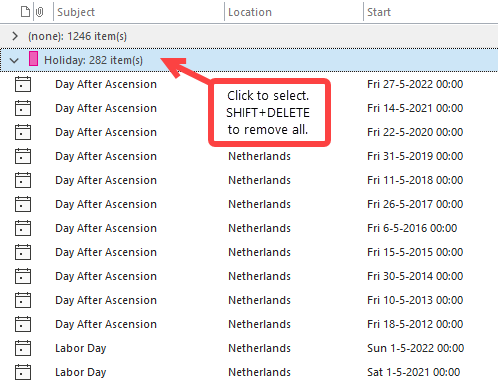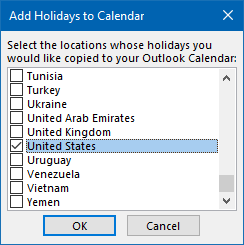Holiday updates for the Outlook Calendar
I found that the latest holidays are missing from my calendar. I checked for updates but none are there and manually trying to install the latest holiday updates gives an error that the update is already installed or does not apply to my system.
How can I get the latest holidays to show up?
 After applying updates that contain new holiday information, the newly included holidays are not directly added to your Calendar. You’ll have to reselect the option to include the holidays for a specific country in your Calendar.
After applying updates that contain new holiday information, the newly included holidays are not directly added to your Calendar. You’ll have to reselect the option to include the holidays for a specific country in your Calendar.
To prevent duplicates, it is recommended that you delete the currently imported holidays from your Calendar before importing the holidays again.
Remove current holidays
The easiest way to remove previously imported holidays from your Calendar is via the “By Category” view;
- Outlook 2007
View-> Current View-> By Category - Outlook 2010 / 2013 / 2016 / 2019 / Microsoft 365 (Classic Ribbon)
- View-> Change View-> List
- In the Arrangement group select: Categories
- Microsoft 365 (Single Line Ribbon)
- View-> Change View-> List
- Arrange By-> Categories
Now you can easily select all the items that have the Holiday category (by clicking on the Holiday group header) and delete them all at once. If you use SHIFT+Delete to delete them, you’ll skip the Delete Items folder and permanently delete them.

Deleting all Holidays at once is easy via a By Category sorted view.
Import new holidays
To import the new holidays you can reselect the option for the holidays of your country in the Add Holidays… dialog;
- Outlook 2007
Tools-> Options…-> button: Calendar Options…-> button: Add Holidays… - Outlook 2010 / 2013 / 2016 / 2019 / Microsoft 365
File-> Options-> section: Calendar-> group: Calendar Options-> button: Add Holidays…
Holiday updates
 Microsoft uses regular Office updates to include new holidays or update or remove existing ones. Therefor, make sure you’ve installed the latest updates before importing your holidays.
Microsoft uses regular Office updates to include new holidays or update or remove existing ones. Therefor, make sure you’ve installed the latest updates before importing your holidays.
Below is an overview of up to which year holidays are included for each Outlook version.
- Outlook 2007 / Outlook 2010
Includes holidays up to 2028 but many only go up to 2020. - Outlook 2013
Includes holidays up to 2022. - Outlook 2016 (msi only)
Includes holidays up to 2026. - Outlook 2016 / Outlook 2019 / Microsoft 365
Includes holidays up to 2026. - All versions (standalone hol-file by Microsoft)
This is the same one for an up-to-date Outlook 2007 and Outlook 2010.
Includes holidays up to 2028 but many only go up to 2020. - All versions (standalone hol-file by MSOutlook.info)
Includes holidays up to 2026 (similar to Microsoft 365).
Note: The standalone hol-file can be used with all Outlook versions and not just Outlook 2007 and Outlook 2010 as the download page might suggest. See below for more information on how to import the holidays included in the hol-file.
Manual holiday updates (hol- files)
Outlook holiday files have the .hol extension. If you have an updated hol-file that you wish to use with Outlook, then you can simply double click it to to launch the “Add Holidays to Calendar” dialog. You can use this method for instance to import holiday updates or custom holidays or vacation lists provided by your company.
When you create a hol-file of your own, make sure you save it in the Unicode format (use the Save As… option when using Notepad).

When you have an updated holidays file (.hol),
you can double click on it to directly open it with
Outlook and select which holidays to import.
Replacing the current hol-file of Outlook
If you want it to replace the holidays list of Outlook, then you can overwrite the outlook.hol file that is located in the language ID folder of the Office installation directory.
Examples of locations:
- English version of Outlook 2007 on a 32-bit version of Windows
C:\Program Files\Microsoft Office\Office12\1033 - English version of 32-bit Outlook 2010 on a 64-bit version of Windows
C:\Program Files\Microsoft Office (x86)\Office14\1033 - Dutch version of 64-bit Outlook 2010 on a 64-bit version of Windows
C:\Program Files\Microsoft Office\Office14\1043 - English version of 64-bit Outlook 2013 on a 64-bit version of Windows
C:\Program Files\Microsoft Office\Office15\1033 - English version of 64-bit Outlook 2016 on a 64-bit version of Windows
C:\Program Files\Microsoft Office\Office16\1033
Note: To lookup the language ID folder for your language you can use this table. You need to look in the "LCID" column for the correct number.
Note 2: Overwriting the outlook.hol file is not a supported method for Microsoft 365 and Click-to-Run installations of Office.

